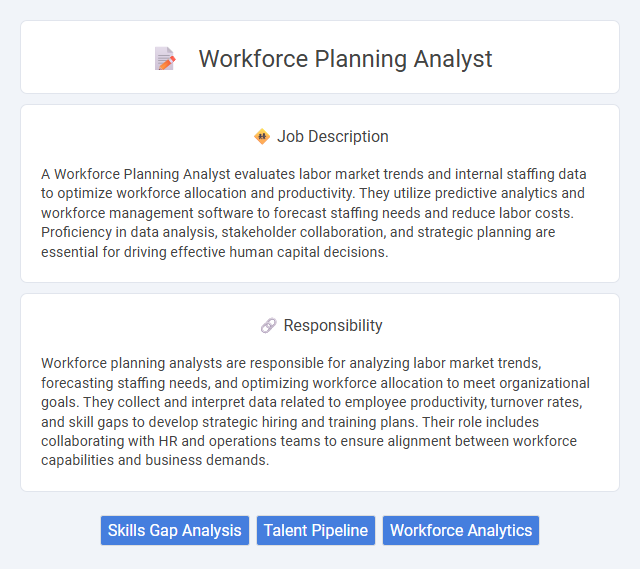
A Workforce Planning Analyst evaluates labor market trends and internal staffing data to optimize workforce allocation and productivity. They utilize predictive analytics and workforce management software to forecast staffing needs and reduce labor costs. Proficiency in data analysis, stakeholder collaboration, and strategic planning are essential for driving effective human capital decisions.
Individuals with strong analytical skills and a keen interest in data interpretation are likely to be well-suited for a Workforce Planning Analyst role. Those comfortable with forecasting, identifying trends, and strategic workforce allocation may find this position aligns with their strengths. Candidates who prefer dynamic environments requiring adaptability and effective communication are probably better equipped to excel in this job.
Qualification
A Workforce Planning Analyst typically requires a bachelor's degree in human resources, business administration, or a related field, with strong analytical and data management skills. Proficiency in workforce analytics tools, forecasting models, and advanced Excel or data visualization software such as Tableau or Power BI is essential. Experience in workforce optimization, strategic planning, and interpreting labor market trends significantly enhances job performance.
Responsibility
Workforce planning analysts are responsible for analyzing labor market trends, forecasting staffing needs, and optimizing workforce allocation to meet organizational goals. They collect and interpret data related to employee productivity, turnover rates, and skill gaps to develop strategic hiring and training plans. Their role includes collaborating with HR and operations teams to ensure alignment between workforce capabilities and business demands.
Benefit
A Workforce Planning Analyst role likely offers significant benefits including enhanced career growth opportunities due to its critical function in optimizing staffing and operational efficiency. Employees in this role probably gain valuable experience in data analysis and strategic decision-making, skills that are increasingly in demand across industries. The position may also provide competitive salaries and job stability as organizations prioritize effective workforce management.
Challenge
Workforce planning analyst roles likely involve navigating complex data sets to predict staffing needs accurately while balancing budget constraints and fluctuating market demands. The challenge may include integrating multiple data sources and forecasting future workforce trends amidst economic uncertainty. Candidates probably need strong analytical skills and the ability to communicate insights effectively to support strategic decisions.
Career Advancement
Workforce planning analysts play a crucial role in optimizing organizational talent by analyzing labor data, forecasting staffing needs, and aligning workforce strategies with business goals. Mastery of data analytics tools and developing expertise in predictive modeling can accelerate career advancement into senior analyst or workforce planning manager positions. Gaining cross-functional experience and certification in human capital analytics significantly enhances prospects for leadership roles within HR and strategic planning departments.
Key Terms
Skills Gap Analysis
A Workforce Planning Analyst specializing in Skills Gap Analysis assesses the current employee skill sets against organizational needs to identify deficiencies and forecast future talent requirements. They utilize data analytics tools and workforce metrics to develop strategic hiring, training, and development plans that align with business goals. Proficiency in HRIS systems, statistical analysis, and strong communication skills are essential for optimizing talent management and minimizing operational risks.
Talent Pipeline
A Workforce Planning Analyst specializing in Talent Pipeline ensures strategic alignment of recruitment and development initiatives to meet future organizational needs. They analyze workforce data, forecast talent supply and demand, and identify skill gaps to optimize recruitment strategies and succession planning. Effective talent pipeline management improves employee retention, reduces hiring costs, and supports long-term business growth.
Workforce Analytics
Workforce planning analysts specializing in workforce analytics utilize data-driven insights to optimize staffing levels, improve productivity, and forecast future talent needs. They analyze employee performance metrics, turnover rates, and labor market trends to develop strategic workforce models that align with organizational goals. Proficiency in advanced analytics tools such as SQL, Python, and data visualization platforms is essential for generating actionable reports and driving evidence-based decision-making.
 kuljobs.com
kuljobs.com